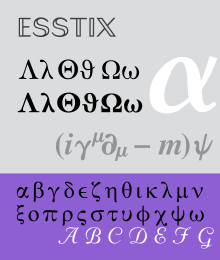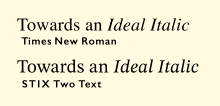STIX Fonts project
 | |
| Category | Various |
|---|---|
| Classification | Transitional |
| Commissioned by | STIX Pub |
| Foundry | MicroPress and others |
| Date created | 2008 |
| Date released | 2010 |
 | |
| Category | Various |
|---|---|
| Classification | Transitional |
| Commissioned by | Elsevier |
| Foundry | Elsevier |
| Date created | 2000 |
The STIX Fonts project is a project sponsored by several leading scientific and technical publishers to provide, under royalty-free license, a comprehensive font set of mathematical symbols and alphabets, intended to serve the scientific and engineering community for electronic and print publication. The STIX fonts are available as fully hinted OpenType/CFF fonts.[1] There is currently no TrueType version of the STIX fonts available, but the STIX Mission Statement includes the intention to create one in the future.[2] However there exists an unofficial conversion of STIX Fonts (from the beta version release) to TrueType, suitable for use with software without OpenType support.[3]
STIX fonts also include[4] natural language glyphs for Latin, Greek and Cyrillic. The family is designed to be broadly compatible with the Times New Roman family, a popular choice in book publishing.
Composition
Among the glyphs in STIX, 32.9% have been contributed by the project members. The commercial TeX vendor and TeX font foundry MicroPress has been contracted to create the additional glyphs. The STIX project will also create a TeX implementation. Goals also include incorporating the characters into Unicode, and ensuring that browsers can use them.
Members of the STIX (Scientific and Technical Information Exchange) Fonts project, known collectively as the STI Pub consortium, include the American Institute of Physics, the American Chemical Society, the American Mathematical Society, the Institute of Electrical and Electronics Engineers, the American Physical Society, and Elsevier.
The Font contents were assembled from a list of every character/glyph required for publication in the journals of the participating STI Pub companies. Every scientific discipline is represented in this list, as well as many other fields from the arts and humanities.Most of the glyphs in the STIX Fonts have been designed in Times-compatible style. In addition to Times-compatible glyphs, some portions of the STIX Fonts include other design styles such as sans serif, monospace, Fraktur, Script, and calligraphic.
— STIX Fonts website
Development process
A beta version of the fonts was released on October 31, 2007. This version does not include enough of the OpenType mathematical layout features present in Cambria Math, so it is not usable to the fullest extent in Microsoft Office 2007.[5] The Latin glyph set included in the beta version does not yet cover all the characters required to typeset in Eastern European languages.
“Final design changes” were declared “complete” at the project website on 9 June 2008. A release by end of May 2009 for the “initial production release” was announced, still without the support for OpenType layout features of Office 2007 or TeX. In September 2009, the fonts went to the final packaging stage. However in October, missing glyphs were discovered, adding a delay. The fonts were scheduled to be released in April 2010, and released on 2010-05-28.
The project has taken considerably longer than forecast. The website has been updated only intermittently, and thus has regularly been out-of-date, with forecast milestones often being overshot. For example, on 20 July 2011 the main page on the official site[6] stated, "Version 1.1, which will include fonts packaged for use with Microsoft Office applications, is scheduled for release by the end of 2010. [...] This site was last updated on 1 November [2010]." Version 1.1.0 was released February 24, 2012. This version facilitates equation editing in recent versions of Microsoft Word.[7] Version 1.1.0 with LaTeX support was released in May 29 2013.
STIX 2.0.0

On December 1, 2016, the official project website announced the release of STIX version 2.0.0. This was created by Ross Mills and John Hudson of Tiro Typeworks. Unlike the previous version, it is an original design loosely inspired by a smaller 10 point size of Times New Roman, with a higher x-height.[8][9]
Uptake
The STIX Fonts are included in OS X in versions from Lion (10.7) onwards.
The javascript framework MathJax uses the STIX fonts for including mathematics in web pages. Installing the fonts on the local computer improves MathJax’s typesetting speed.[10]
The Math Editor equation editor uses STIX fonts as its primary font.
ESSTIX
A precursor to the STIX project is the ESSTIX (Elsevier Science STIX) font, developed and later donated by Elsevier. It is currently available from the World Wide Web Consortium as part of the Amaya (web browser).[11]
See also
References
- ↑ Owens, Evan (2010-05-28). "Press Release - STIX Fonts Version 1.0 Released". New York City: American Institute of Physics. Retrieved 2010-05-29.
- ↑ STIX Fonts - Mission Statement
- ↑ STIX Fonts - TTF (True Type)
- ↑ Barbara Beeton, “STIX fonts and Unicode”, talk at TUG 2007 video
- ↑ Murray Sargent, (Nov. 6, 2007) STIX Beta Fonts
- ↑ STIX Fonts Project Website, archived on 2011-09-15.
- ↑ STIX Fonts Project Website accessed 2012-03-05.
- ↑ "Tweet". Twitter. Tiro Typeworks. Retrieved 10 December 2016.
The original STIX fonts were based on a Times New Roman clone. The new #STIX2 faces are redesigned, inspired by 10pt metal Times fonts.
- ↑ Twardoch, Adam. "New “STIX Two” opensource fonts by Tiro: http://stixfonts.org/". Facebook. Retrieved 10 December 2016.
The new design is fantastic — it can be described as “the better Times New Roman”. It’s somewhat similar to Times, but with a touch of Fleischmann. Its lower contrast, enlarged x-height and less inclined italic all contribute to superb(!) readability, in both web and print. STIX Text is a neutral, non-invasive text face for continuous reading.
External link in|title=(help) - ↑ MathJax Font Help accessed 2012-08-14.
- ↑
External links
- STIX Fonts project official site
- STIX Fonts at Everything Fonts
- American Mathematical Society’s STIX project site (outdated)
- Math Editor (Free and Open Source equation editor utilizing STIX Fonts)